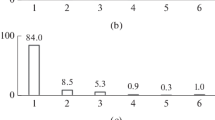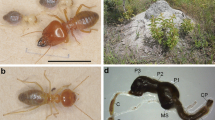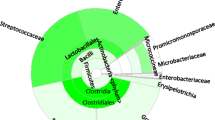Abstract
This comprehensive survey studied the actinobacterial community structure and putative representative members associated with the gut of the wood-feeding termite, Nasutitermes corniger (Motschulsky), using nested PCR-DGGE and 16S rDNA sequences analyses. The closest relatives of the actinobacteria inhabiting the gut of Nasutitermes corniger were in five families, regardless of the geographical origin of the termite colony: Propionibacteriaceae, Streptomycetaceae, Cellulomonodaceae, Corynebacteriaceae and Rubrobacteraceae. Feeding termites on beech wood did not result in substantial changes in the actinobacterial community structure as revealed by DGGE banding patterns. Most of the 16S rDNA sequences obtained after excision and sequencing of DGGE bands clustered with those previously retrieved in termite guts. These results confirm the presence of gut-specific actinobacteria. Except for the 16S rDNA sequences affiliated to Streptomycetaceae and Cellulomonodaceae, no sequence had more than 97% similarity with the closest isolated strains, indicating the presence of microorganisms that have not yet been cultivated. These results suggest that members of the Actinomycetales order account for the largest proportion of the Actinobacteria phylum inhabiting the gut of the termite N. corniger.



Similar content being viewed by others
References
Bignell D.E., Anderson J.M. and Crosse R. 1991. Isolation of facultatively aerobic actinomycetes from the gut, parent soil and mound materials of the termites Procubitermes abutiensis and Cubitermes severus. FEMS Microbiol. Ecol. 85: 151–160
Brauman A., Dore J., Eggleton P., Bignell D., Breznak J.A. and Kane M.D. 2001. Molecular phylogenetic profiling of prokaryotic communities in guts of termites with different feeding habits. FEMS Microbiol. Ecol. 35: 27–36
Breznak J.A. and Brune A. 1994. Role of microorganisms in the digestion of lignocellulose by termite. Annu. Rev. Entomol. 39: 453–487
Brune A. 2006. Symbiotic associations between termites and Prokaryotes. In: The Prokaryotes (3rd ed., Vol. 1): Symbiotic Associations, Biotechnology, Applied Microbiology (Dworkin M., Falkow S., Rosenberg E., Schleifer K.-H. and Stackebrandt E., Eds), Springer, New York. pp 439–474
Donovan S.E., Purdy K.J., Kane M.D. and Eggleton P. 2004. Comparison of Euryarchaea strains in the guts and food-soil of the soil-feeding termite Cubitermes fungifaber across different soil types. Appl. Environ. Microbiol. 70: 3884–3892
Fall S., Hamelin J., Ndiaye F., Assigbetse K., Aragno M., Chotte J.L. and Brauman A. 2007. Differences between bacterial communities in the gut of a soil-feeding termite (Cubitermes niokoloensis) and its mounds. Appl. Environ. Microbiol. 73: 5199–5208
Farris M.H. and Olson J.B. 2007. Detection of Actinobacteria cultivated from environmental samples reveals bias in universal primers. Lett. Appl. Microbiol. 45: 376–381
Hall T.A. 1999. BioEdit: a user-friendly biological sequence alignment editor and analysis program for Windows 95/98/NT. Nucleic Acids Symp. Ser. 41: 95–98
Heuer H., Kresk M., Baker P., Smalla K. and Wellington E.M.H. 1997. Analysis of actinomycete communities by specific amplification of genes encoding 16S rRNA and gel-electrophoretic separation in denaturing gradients. Appl. Environ. Microbiol. 63: 3233–3241
Hongoh Y, Ohkuma M. and Kudo T. 2003. Molecular analysis of bacterial microbiota in the gut of the termite Reticulitermes speratus (Isoptera; Rhinotermitidae). FEMS Microbiol. Ecol. 44: 231–242
Hongoh Y., Deevong P., Inoue T., Moriya S., Trakulnaleamsai S., Ohkuma M., Vongkaluang C., Noparatnaraporn N. and Kudo T. 2005. Intra- and interspecific comparisons of bacterial diversity and community structure support coevolution of gut microbiota and termite host. Appl. Environ. Microbiol. 71: 6590–6599
Hongoh Y., Ekpornprasit, Inoue T., Moryia S., Trakulnaleamsai S., Ohkuma M., Noparatnaraporn N. and Kudo T. 2006. Intracolony variation of bacterial gut microbiota among castes and ages in the fungus-growing termite Macrotermes gilvus. Mol. Ecol. 15: 505–516
Hungate R.E. 1946. Studies on cellulose fermentation II. An anaerobic cellulose-decomposing actinomycete, Micromonospora propionici, N. Sp. J. Bacteriol. 51: 51–56
Kawase T., Saito A., Sato T., Kanai R., Fujii T., Nikaidou N., Miyashita K. and Watanabe T. 2004. Distribution and phylogenetic analysis of family 19 chitinases in Actinobacteria. Appl. Environ. Microbiol. 70: 1135–1144
Kuhnigk T. and König H. 1997. Degradation of dimeric lignin model compounds by aerobic bacteria isolated from the hindgut of xylophagous termites. J. Basic Microbiol. 37: 205–211
Kurtböke D.I. and French J.R.J. 2007. Use of phage battery to investigate the actinofloral layers of termite gut microflora. J. Appl. Microbiol. 103: 722–734
Miyata R., Noda N., Tamaki H., Kinjyo K., Aoyagi H., Uchiyama H. and Tanaka H. 2007. Influence of feed components on symbiotic bacterial community structure in the gut of the wood-feeding higher termite Nasutitermes takasagoensis. Biosci. Biotechnol. Biochem. 71: 1244–1251
Muyzer G., de Wall E.C. and Uitterlinden A.G. 1993. Profiling of complex microbial populations by denaturing gradient gel electrophoresis analysis of polymerase chain reaction-amplified genes coding for 16S rRNA. Appl. Environ. Microbiol. 59: 3233–3241
Nakajima H., Hongoh Y., Usami R., Kudo T. and Ohkuma M. 2005. Spatial distribution of bacterial phylotypes in the gut of the termite Reticulitermes speratus and the bacterial community colonizing the gut epithelium. FEMS Microbiol. Ecol. 54: 247–255
Nakatsu C.H. 2007. Soil microbial community analysis using denaturing gradient gel electrophoresis. Soil Sci. Soc. Am. J. 71: 562–571
Nübel U., Engelen B., Felske A., Snaidr J., Wieshuber A., Amann R.I., Ludwig W. and Backhaus H. 1996. Sequence heterogeneities of genes encoding 16S rRNAs in Paenibacillus polymyxa detected by temperature gradient gel electrophoresis. J. Bacteriol. 178: 5636–5643
Ohkuma M. and Kudo T. 1996. Phylogenetic diversity of the intestinal bacterial community in the termite Reticulitermes speratus. Appl. Env. Microbiol. 62: 461–468
Pasti M.B. and Belli M.L. 1985. Cellulolytic activity of actinomycetes isolated from termites (Termitidae) gut. FEMS Microbiol. Lett. 26: 107–112
Porteus L.A., Seidler R.J. and Watrud L.S. 1997. An improved method for purifying DNA from soil for polymerase chain reaction amplification and molecular ecology applications. Mol. Ecol. 6: 787–791
Rheims H. and Stackebrandt E. 1999. Application of nested polymerase chain reaction for the detection of as yet uncultured organisms of the class Actinobacteria in environmental samples. Environ. Microbiol. 1: 137–143
Schmitt-Wagner D., Friedrich M.W., Wagner B. and Brune A. 2003. Axial dynamics, stability, and interspecies similarity of bacterial community structure in the highly compartmentalized gut of soil-feeding termites (Cubitermes spp.). Appl. Environ. Microbiol. 69: 6018–6024
Shinzato N., Muramatu M., Matsui T. and Watanabe Y. 2005. Molecular phylogenetic diversity of the bacterial community in the gut of the termite Coptotermes formosanus. Biosci. Biotechnol. Biochem. 69: 1145–1155
Shinzato N., Muramatu M., Matsui T. and Watanabe Y. 2007. Phylogenetic analysis of the gut bacterial microflora of the fungus-growing termite Odontotermes formosanus. Biosci. Biotechnol. Biochem. 71: 906–915
Smalla K., Oros-Sichler M., Milling A., Heuer H., Baumgarte S., Becker R., Neuber G., Kropf S., Ulrich A. and Tebbe C.C. 2007. Bacterial diversity of soils assessed by DGGE, T-RFLP and SSCP fingerprints of PCR-amplified 16S rRNA gene fragments: Do the different methods provide similar results? J. Microbiol. Methods 69: 470–479
Stach J.E.M., Maldonado L.A., Ward A.C., Goodfellow M. and Bull A.T. 2003. New primers for the class Actinobacteria: application to marine and terrestrial environments. Env. Microbiol. 5: 828–841
Tamura K., Dudley J., Nei M. and Kumar S. 2007. MEGA4: Molecular Evolutionary Genetics Analysis (MEGA) software version 4.0. Mol. Biol. Evol. 24: 1596–1599
Tanaka H., Aoyagi H., Shina S., Dodo Y., Yoshimura T., Nakamura R. and Uchiyama H. 2006. Influence of the diet components on the symbiotic microorganisms community in hindgut of Coptotermes formosanus Shiraki. Appl. Environ. Biotechnol. 71: 907–917
Thompson J.D., Higgins D.G. and Gibson T.J. 1994. CLUSTAL W: Improving the sensitivity of progressive multiple sequence weighing, position-specific gap penalties and weight matrix choice. Nucleic Acid Res 76: 4350–4354
Warnecke F. and Hess M. 2009. A perspective: Metatranscriptomics as a tool for the discovery of novel biocatalysts. J. Biotechnol., in press
Watanabe Y., Shinzato N. and Fukatsu T. 2003. Isolation of actinomycetes from termites’ guts. Biosci. Biotechnol. Biochem. 67: 1797–1801
von Wintzingerode F., Göbel U.B. and Stackebrandt E. 1997. Determination of microbial diversity in environmental samples: pitfalls of PCR-based rRNA analysis. FEMS Microbiol. Rev. 21: 213–219
Acknowledgments
We are grateful to Dr Gladys Loranger-Merciris, from the University Antilles-Guyane (Point-à-Pitre, Guadeloupe, France), and to Dr Alain Robert and Dr Christian Bordereau, from the University of Bourgogne (Dijon, France), for their valuable help in providing and identifying termites.
Author information
Authors and Affiliations
Corresponding author
Rights and permissions
About this article
Cite this article
Lefebvre, T., Miambi, E., Pando, A. et al. Gut-specific actinobacterial community structure and diversity associated with the wood-feeding termite species, Nasutitermes corniger (Motschulsky) described by nested PCR-DGGE analysis. Insect. Soc. 56, 269–276 (2009). https://doi.org/10.1007/s00040-009-0020-6
Received:
Revised:
Accepted:
Published:
Issue Date:
DOI: https://doi.org/10.1007/s00040-009-0020-6




